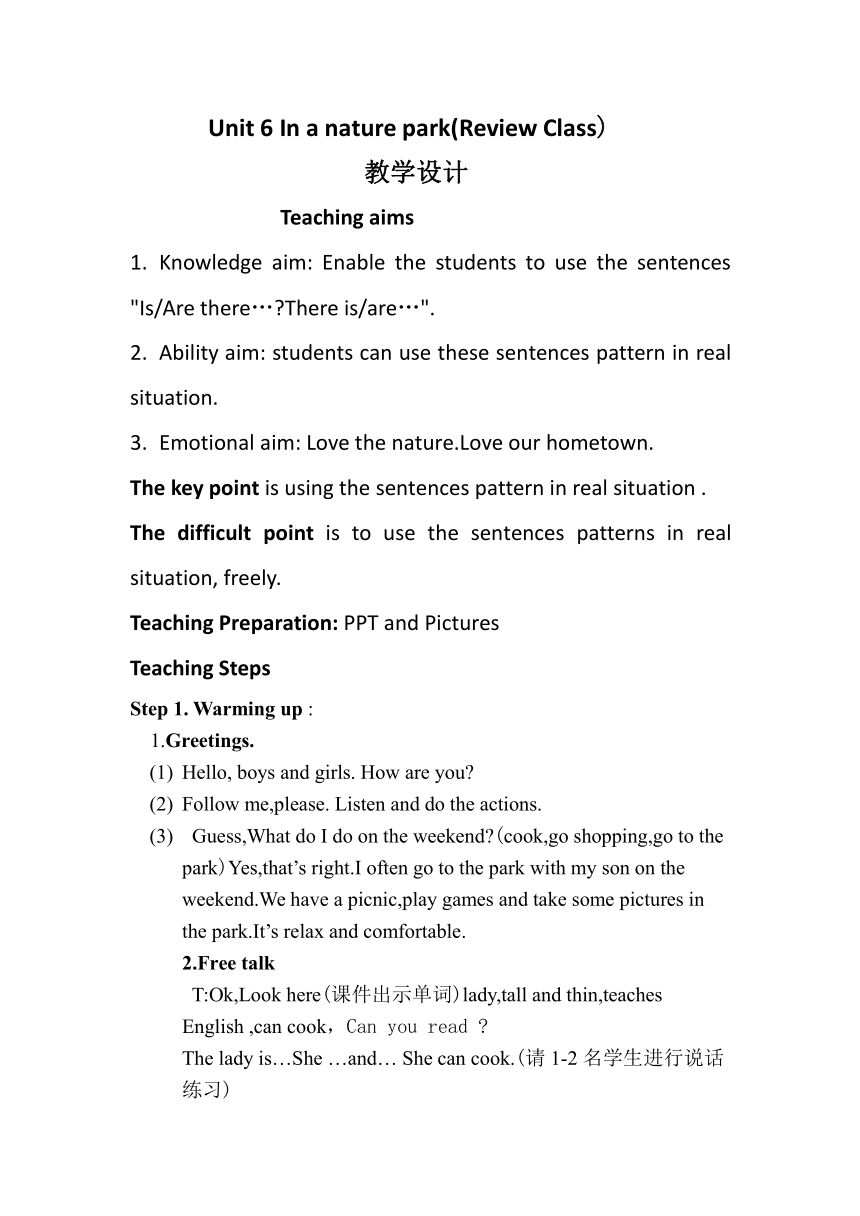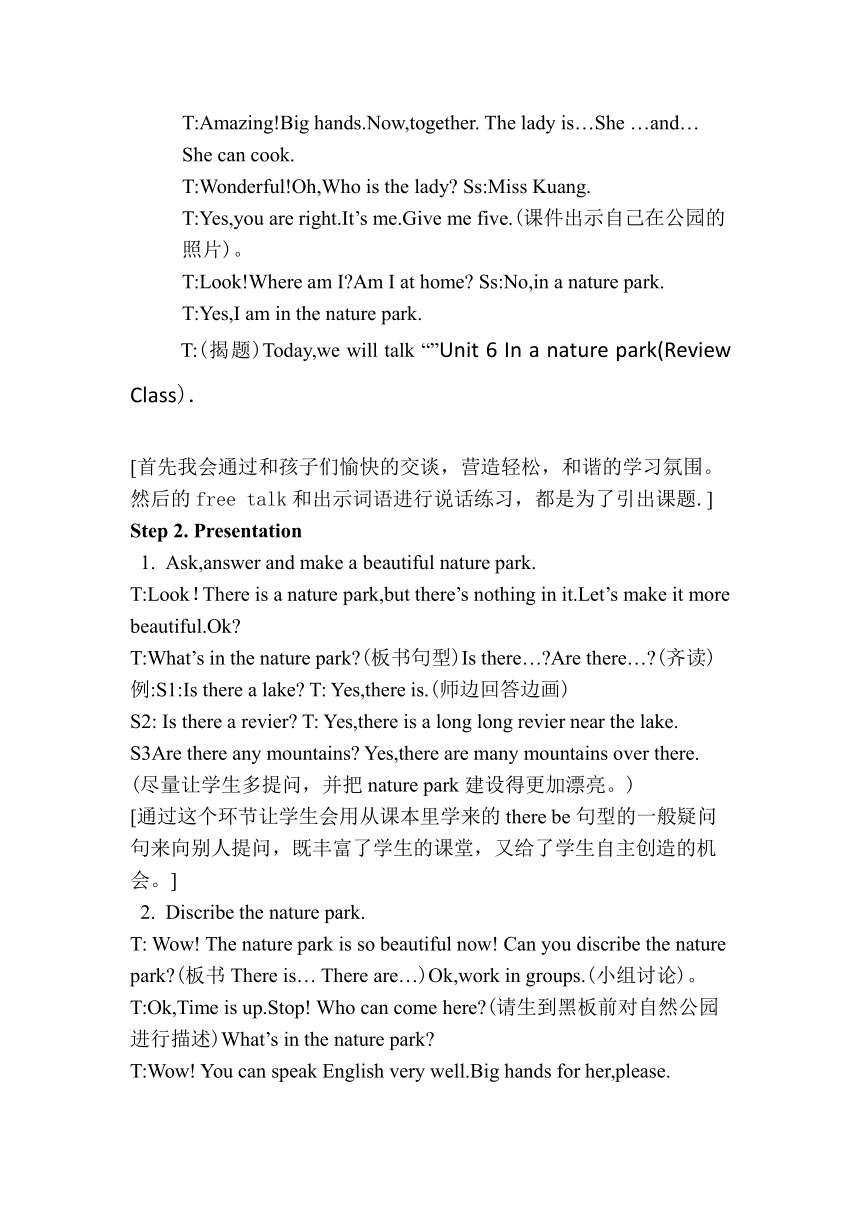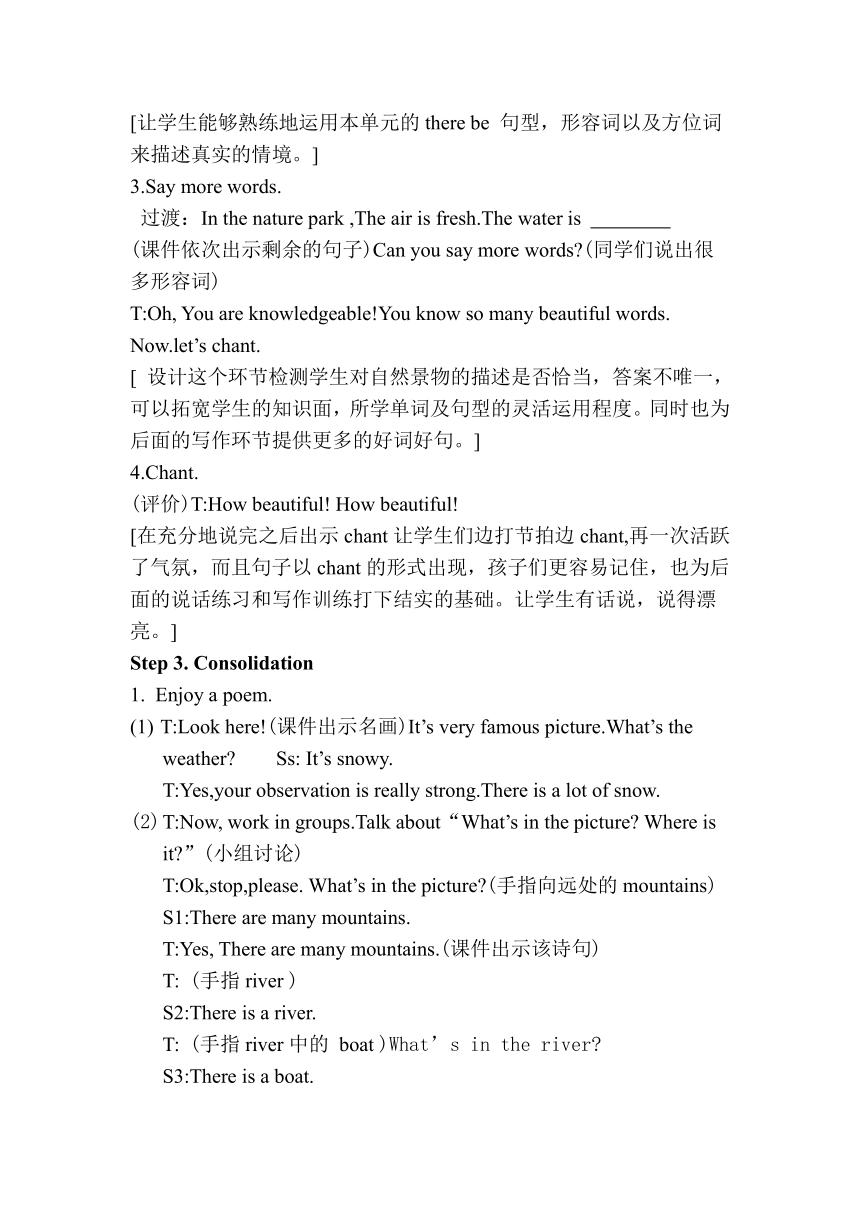Unit6 In a nature PartC 教学设计
文档属性
| 名称 | Unit6 In a nature PartC 教学设计 |

|
|
| 格式 | zip | ||
| 文件大小 | 11.2KB | ||
| 资源类型 | 教案 | ||
| 版本资源 | 人教版(PEP) | ||
| 科目 | 英语 | ||
| 更新时间 | 2019-11-28 16:05:06 | ||
图片预览



文档简介
Unit 6 In a nature park(Review Class)
教学设计
Teaching aims
Knowledge aim: Enable the students to use the sentences "Is/Are there…?There is/are…".
Ability aim: students can use these sentences pattern in real situation.
Emotional aim: Love the nature.Love our hometown.
The key point is using the sentences pattern in real situation . The difficult point is to use the sentences patterns in real situation, freely.
Teaching Preparation: PPT and Pictures
Teaching Steps
Step 1. Warming up :
1.Greetings.
Hello, boys and girls. How are you?
Follow me,please. Listen and do the actions.
Guess,What do I do on the weekend?(cook,go shopping,go to the park)Yes,that’s right.I often go to the park with my son on the weekend.We have a picnic,play games and take some pictures in the park.It’s relax and comfortable.
2.Free talk
T:Ok,Look here(课件出示单词)lady,tall and thin,teaches English ,can cook,Can you read ?
The lady is…She …and… She can cook.(请1-2名学生进行说话练习)
T:Amazing!Big hands.Now,together. The lady is…She …and… She can cook.
T:Wonderful!Oh,Who is the lady? Ss:Miss Kuang.
T:Yes,you are right.It’s me.Give me five.(课件出示自己在公园的照片)。
T:Look!Where am I?Am I at home? Ss:No,in a nature park.
T:Yes,I am in the nature park.
T:(揭题)Today,we will talk “”Unit 6 In a nature park(Review Class).
[首先我会通过和孩子们愉快的交谈,营造轻松,和谐的学习氛围。然后的free talk和出示词语进行说话练习,都是为了引出课题.]
Step 2. Presentation
Ask,answer and make a beautiful nature park.
T:Look!There is a nature park,but there’s nothing in it.Let’s make it more beautiful.Ok?
T:What’s in the nature park?(板书句型)Is there…?Are there…?(齐读)
例:S1:Is there a lake? T: Yes,there is.(师边回答边画)
S2: Is there a revier? T: Yes,there is a long long revier near the lake.
S3Are there any mountains? Yes,there are many mountains over there.
(尽量让学生多提问,并把nature park建设得更加漂亮。)
[通过这个环节让学生会用从课本里学来的there be句型的一般疑问句来向别人提问,既丰富了学生的课堂,又给了学生自主创造的机会。]
Discribe the nature park.
T: Wow! The nature park is so beautiful now! Can you discribe the nature park?(板书There is… There are…)Ok,work in groups.(小组讨论)。
T:Ok,Time is up.Stop! Who can come here?(请生到黑板前对自然公园进行描述)What’s in the nature park?
T:Wow! You can speak English very well.Big hands for her,please.
[让学生能够熟练地运用本单元的there be 句型,形容词以及方位词来描述真实的情境。]
3.Say more words.
过渡:In the nature park ,The air is fresh.The water is
(课件依次出示剩余的句子)Can you say more words?(同学们说出很多形容词)
T:Oh, You are knowledgeable!You know so many beautiful words. Now.let’s chant.
[ 设计这个环节检测学生对自然景物的描述是否恰当,答案不唯一,可以拓宽学生的知识面,所学单词及句型的灵活运用程度。同时也为后面的写作环节提供更多的好词好句。]
4.Chant.
(评价)T:How beautiful! How beautiful!
[在充分地说完之后出示chant让学生们边打节拍边chant,再一次活跃了气氛,而且句子以chant的形式出现,孩子们更容易记住,也为后面的说话练习和写作训练打下结实的基础。让学生有话说,说得漂亮。]
Step 3. Consolidation
Enjoy a poem.
T:Look here!(课件出示名画)It’s very famous picture.What’s the weather? Ss: It’s snowy.
T:Yes,your observation is really strong.There is a lot of snow.
T:Now, work in groups.Talk about“What’s in the picture? Where is it?”(小组讨论)
T:Ok,stop,please. What’s in the picture?(手指向远处的mountains)
S1:There are many mountains.
T:Yes, There are many mountains.(课件出示该诗句)
T: (手指river )
S2:There is a river.
T: (手指river中的 boat )What’s in the river?
S3:There is a boat.
T:Yes, In the snowy river,there is a boat.(课件出示该诗句)
T: (手指船上的人 )
S4:There is a people.
T:Yes,There is an old man. What is the old man doing?
S5:He is rowing a boat.
S6:He is fishing.
T:Yes,He is fishing alone in the snow. (课件出示该诗句)
T:Are there any birds?
Ss:No.
T:There aren’t any birds. (课件出示该诗句以及剩下的诗句)
T:It’s a wonderful poem.Follow me.please.(带读诗句)
T:Do you know this Chinese poem? It’s name is“江雪”(课件出示江雪汉语古诗)Ok,let’s read it again.(配乐朗读英文诗)
T:(评价)What a nice picture !What a wonderful poem!
小结:In English poem,there are more words.but in Chinese poem,there are only 20 words.Chinese poem is powerful.We love China.
[通过这一环节,丰富了学生的课外知识,让学生学会小组合作并解决问题。,他们便能更好地在真实语境中感受并实际运用语言,达到学!以!致!用。]
2.Listen and write the song.Then try to sing.
3.Kown some famous mountains
过渡:In China,there are many many great mountains.Taishan Mountain,Huangshan Mountain,Lushan Mountain and Zhangjiajie.(边介绍边出示名山图片)They are all famous and great.Ok,let’s enjoy some other scenery pictures.(配乐欣赏武功山美景)
[在欣赏完著名的画和诗歌之后,接着又欣赏了祖国的几大名山,之后又欣赏一组武功山的自然风光图,从而激发孩子们热爱大自然,热爱家乡之情。将本堂课的情感进行高度的升华]。
T:Where is it? Ss:Wugong Mountain.
T:How about Wugong Mountain?
Ss:It’s tall/high/beautiful…
T:What’s in Wugong Mountain?(课件再出示一组图片和句型There is/are... … is/are beautiful/clean/green…)
Ok,work in groups.Talk about ,then tell me,please.(小组讨论)
过渡:T:You did a good job.Wugong Mountain is really beautiful.It’s famous in Jiangxi.Every year,there are many people get there.They climb mountains.go hiking,go camping and take some pictures.Especially,on Tents Festival,there are more people climb Wugong Mountain.Sometimes,there are some foreigners.Can you help the people from other countries?
3.Write a small composition about Wugong Mountain and introduce.
Ok,first,wrtie down on this paper.Then,let’s introduce.
T:Ok,Time is up.Have you fnish?Stop,please.Let’s listen to her introduction.(请两名学生上台展示)
T:Good introduction.Big hands.
[趁热打铁,在孩子们欣赏完美丽的武功山之后,迫不及待地有话要说的时候,让孩子们把自己看到的写下来。从前面的听,说,读过渡到了写,最后还敢于上台向大家介绍Wugong Mountain,孩子们运用语言的能力又进一步提升了。]
Step 4. Homework
Your homework is Write the small composition on your exercise book and then read it for your friends.(把这篇小作文写到作业本上,然后
读给你的朋友听听。)
[由于课堂时间有限,有少数学生也许还没有写完,老师也来不及展示更多的作品,于是让学生们回去把小作文誊抄在作业本上方便老师批改,并念给朋友或父母听,在念的过程中,又锻炼了学生运用语言的能力。]
Step5. blackboard design
Unit6 In a nature park
Review Class
Is there…?
Are there…?
There is…
There are…
[好的板书是一节课的高度浓缩与精华,它给学生以文化艺术的熏陶,是一节课的灵魂。]
Step6:Teaching reflection
这是一节复习课,课堂容量大。为了让学生学会鲜活的语言,我结合教材和学生的特点,编创了教学内容,创设了真实的情景,比如,让学生make the nature park more beautiful.和最后的武功山环节。从学生的课堂表现来看,学生对话题很感兴趣,学生不仅有话说,乐意说,而且能够灵活掌握本单元的there be句型(包括肯定句和一般疑问句及其回答)。学生练习右易到难,层层递进,学生的综合语言运用能力得到提升,情感得到升华。
由于我是第一次参与这样的比赛课,更是由于自己的性格因素,课堂上总是抓得太紧,不敢轻易放手,生怕学生说错。课堂上不够灵活等等,这些都需要在今后的教学中不断改进。
教学设计
Teaching aims
Knowledge aim: Enable the students to use the sentences "Is/Are there…?There is/are…".
Ability aim: students can use these sentences pattern in real situation.
Emotional aim: Love the nature.Love our hometown.
The key point is using the sentences pattern in real situation . The difficult point is to use the sentences patterns in real situation, freely.
Teaching Preparation: PPT and Pictures
Teaching Steps
Step 1. Warming up :
1.Greetings.
Hello, boys and girls. How are you?
Follow me,please. Listen and do the actions.
Guess,What do I do on the weekend?(cook,go shopping,go to the park)Yes,that’s right.I often go to the park with my son on the weekend.We have a picnic,play games and take some pictures in the park.It’s relax and comfortable.
2.Free talk
T:Ok,Look here(课件出示单词)lady,tall and thin,teaches English ,can cook,Can you read ?
The lady is…She …and… She can cook.(请1-2名学生进行说话练习)
T:Amazing!Big hands.Now,together. The lady is…She …and… She can cook.
T:Wonderful!Oh,Who is the lady? Ss:Miss Kuang.
T:Yes,you are right.It’s me.Give me five.(课件出示自己在公园的照片)。
T:Look!Where am I?Am I at home? Ss:No,in a nature park.
T:Yes,I am in the nature park.
T:(揭题)Today,we will talk “”Unit 6 In a nature park(Review Class).
[首先我会通过和孩子们愉快的交谈,营造轻松,和谐的学习氛围。然后的free talk和出示词语进行说话练习,都是为了引出课题.]
Step 2. Presentation
Ask,answer and make a beautiful nature park.
T:Look!There is a nature park,but there’s nothing in it.Let’s make it more beautiful.Ok?
T:What’s in the nature park?(板书句型)Is there…?Are there…?(齐读)
例:S1:Is there a lake? T: Yes,there is.(师边回答边画)
S2: Is there a revier? T: Yes,there is a long long revier near the lake.
S3Are there any mountains? Yes,there are many mountains over there.
(尽量让学生多提问,并把nature park建设得更加漂亮。)
[通过这个环节让学生会用从课本里学来的there be句型的一般疑问句来向别人提问,既丰富了学生的课堂,又给了学生自主创造的机会。]
Discribe the nature park.
T: Wow! The nature park is so beautiful now! Can you discribe the nature park?(板书There is… There are…)Ok,work in groups.(小组讨论)。
T:Ok,Time is up.Stop! Who can come here?(请生到黑板前对自然公园进行描述)What’s in the nature park?
T:Wow! You can speak English very well.Big hands for her,please.
[让学生能够熟练地运用本单元的there be 句型,形容词以及方位词来描述真实的情境。]
3.Say more words.
过渡:In the nature park ,The air is fresh.The water is
(课件依次出示剩余的句子)Can you say more words?(同学们说出很多形容词)
T:Oh, You are knowledgeable!You know so many beautiful words. Now.let’s chant.
[ 设计这个环节检测学生对自然景物的描述是否恰当,答案不唯一,可以拓宽学生的知识面,所学单词及句型的灵活运用程度。同时也为后面的写作环节提供更多的好词好句。]
4.Chant.
(评价)T:How beautiful! How beautiful!
[在充分地说完之后出示chant让学生们边打节拍边chant,再一次活跃了气氛,而且句子以chant的形式出现,孩子们更容易记住,也为后面的说话练习和写作训练打下结实的基础。让学生有话说,说得漂亮。]
Step 3. Consolidation
Enjoy a poem.
T:Look here!(课件出示名画)It’s very famous picture.What’s the weather? Ss: It’s snowy.
T:Yes,your observation is really strong.There is a lot of snow.
T:Now, work in groups.Talk about“What’s in the picture? Where is it?”(小组讨论)
T:Ok,stop,please. What’s in the picture?(手指向远处的mountains)
S1:There are many mountains.
T:Yes, There are many mountains.(课件出示该诗句)
T: (手指river )
S2:There is a river.
T: (手指river中的 boat )What’s in the river?
S3:There is a boat.
T:Yes, In the snowy river,there is a boat.(课件出示该诗句)
T: (手指船上的人 )
S4:There is a people.
T:Yes,There is an old man. What is the old man doing?
S5:He is rowing a boat.
S6:He is fishing.
T:Yes,He is fishing alone in the snow. (课件出示该诗句)
T:Are there any birds?
Ss:No.
T:There aren’t any birds. (课件出示该诗句以及剩下的诗句)
T:It’s a wonderful poem.Follow me.please.(带读诗句)
T:Do you know this Chinese poem? It’s name is“江雪”(课件出示江雪汉语古诗)Ok,let’s read it again.(配乐朗读英文诗)
T:(评价)What a nice picture !What a wonderful poem!
小结:In English poem,there are more words.but in Chinese poem,there are only 20 words.Chinese poem is powerful.We love China.
[通过这一环节,丰富了学生的课外知识,让学生学会小组合作并解决问题。,他们便能更好地在真实语境中感受并实际运用语言,达到学!以!致!用。]
2.Listen and write the song.Then try to sing.
3.Kown some famous mountains
过渡:In China,there are many many great mountains.Taishan Mountain,Huangshan Mountain,Lushan Mountain and Zhangjiajie.(边介绍边出示名山图片)They are all famous and great.Ok,let’s enjoy some other scenery pictures.(配乐欣赏武功山美景)
[在欣赏完著名的画和诗歌之后,接着又欣赏了祖国的几大名山,之后又欣赏一组武功山的自然风光图,从而激发孩子们热爱大自然,热爱家乡之情。将本堂课的情感进行高度的升华]。
T:Where is it? Ss:Wugong Mountain.
T:How about Wugong Mountain?
Ss:It’s tall/high/beautiful…
T:What’s in Wugong Mountain?(课件再出示一组图片和句型There is/are... … is/are beautiful/clean/green…)
Ok,work in groups.Talk about ,then tell me,please.(小组讨论)
过渡:T:You did a good job.Wugong Mountain is really beautiful.It’s famous in Jiangxi.Every year,there are many people get there.They climb mountains.go hiking,go camping and take some pictures.Especially,on Tents Festival,there are more people climb Wugong Mountain.Sometimes,there are some foreigners.Can you help the people from other countries?
3.Write a small composition about Wugong Mountain and introduce.
Ok,first,wrtie down on this paper.Then,let’s introduce.
T:Ok,Time is up.Have you fnish?Stop,please.Let’s listen to her introduction.(请两名学生上台展示)
T:Good introduction.Big hands.
[趁热打铁,在孩子们欣赏完美丽的武功山之后,迫不及待地有话要说的时候,让孩子们把自己看到的写下来。从前面的听,说,读过渡到了写,最后还敢于上台向大家介绍Wugong Mountain,孩子们运用语言的能力又进一步提升了。]
Step 4. Homework
Your homework is Write the small composition on your exercise book and then read it for your friends.(把这篇小作文写到作业本上,然后
读给你的朋友听听。)
[由于课堂时间有限,有少数学生也许还没有写完,老师也来不及展示更多的作品,于是让学生们回去把小作文誊抄在作业本上方便老师批改,并念给朋友或父母听,在念的过程中,又锻炼了学生运用语言的能力。]
Step5. blackboard design
Unit6 In a nature park
Review Class
Is there…?
Are there…?
There is…
There are…
[好的板书是一节课的高度浓缩与精华,它给学生以文化艺术的熏陶,是一节课的灵魂。]
Step6:Teaching reflection
这是一节复习课,课堂容量大。为了让学生学会鲜活的语言,我结合教材和学生的特点,编创了教学内容,创设了真实的情景,比如,让学生make the nature park more beautiful.和最后的武功山环节。从学生的课堂表现来看,学生对话题很感兴趣,学生不仅有话说,乐意说,而且能够灵活掌握本单元的there be句型(包括肯定句和一般疑问句及其回答)。学生练习右易到难,层层递进,学生的综合语言运用能力得到提升,情感得到升华。
由于我是第一次参与这样的比赛课,更是由于自己的性格因素,课堂上总是抓得太紧,不敢轻易放手,生怕学生说错。课堂上不够灵活等等,这些都需要在今后的教学中不断改进。
